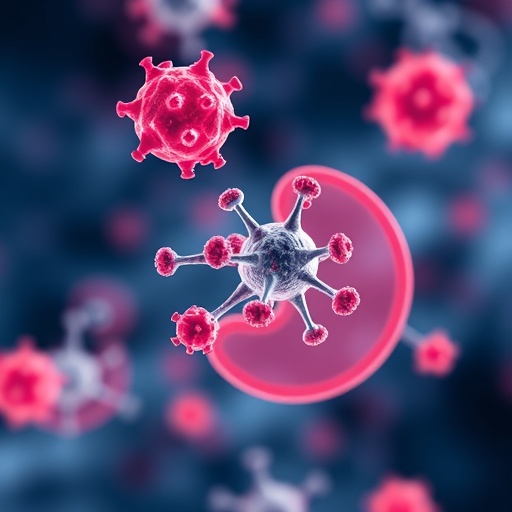Emerging research has unveiled a critical vulnerability in pancreatic ductal adenocarcinoma (PDAC), a notoriously aggressive cancer characterized by poor prognosis and limited treatment options. Scientists have identified that inhibiting PIKfyve, a lipid kinase involved in intracellular membrane dynamics, compels PDAC cells to engage a compensatory metabolic program centered on de novo lipid synthesis. This revelation not only advances our understanding of PDAC metabolism but also opens new therapeutic avenues targeting lipid biosynthesis pathways synergistically with PIKfyve inhibition.
To meticulously dissect the metabolic dependencies imposed by PIKfyve inhibition, the study employed robust metabolism-focused CRISPR screening strategies in MIA PaCa-2 PDAC cells. Utilizing two different doses of the PIKfyve inhibitor apilimod, researchers mapped the genetic factors influencing cellular fitness under these metabolic stresses. The high-dose CRISPR screen distinctly highlighted genes instrumental in cholesterol, fatty acid synthesis, fatty acid elongation, and sphingolipid biosynthetic pathways, including SLC25A1, FDFT1, SQLE, FDPS, LSS, FASN, ACACA, ELOVL1, HSD17B12, TECR, SPTLC1, SPTLC2, and KDSR. Remarkably, the lower dose screen corroborated these findings, underscoring fatty acid synthesis and elongation as critical pathways engaging under sublethal PIKfyve inhibition.
A particularly intriguing observation emerged from both high and low-dose screens surrounding ACOX1, a pivotal enzyme catalyzing the initial step in lipid beta-oxidation. The enrichment of single guide RNAs targeting ACOX1 suggested that PDAC cells may rely heavily on shifting their lipid catabolic processes when PIKfyve is inhibited, further intensifying their dependence on lipid anabolism. Collectively, these data indicate a synthetic lethal relationship between PIKfyve function and the cellular machinery dedicated to de novo lipid biosynthesis.
To validate these genetic insights, the researchers performed targeted perturbations of the identified metabolic genes. CRISPR interference-mediated knockdown of FASN, a key fatty acid synthase, markedly sensitized PDAC cells to apilimod treatment as well as to PIK5-33d, a potent PIKfyve degrader. This sensitization extended to ACC1, encoded by the ACACA gene, whose enzymatic activity in catalyzing acetyl-CoA carboxylation represents the rate-limiting step in fatty acid synthesis. Pharmacological inhibition of ACC1 with the small molecule ND646 intensified cytotoxicity when combined with PIKfyve inhibitors, confirming metabolic co-dependencies at the enzymatic level.
Moreover, knockdown of SPTLC1 and SPTLC2, genes encoding serine palmitoyltransferase subunits involved in sphingolipid biosynthesis, displayed a synthetic interaction with PIKfyve inhibition; while depletion alone was non-lethal, these perturbations significantly compromised cell viability upon apilimod exposure. Similarly, pharmacological inhibitors targeting enzymes essential to cholesterol synthesis—FDFT1 and SQLE—also sensitized PDAC cells to PIKfyve blockade. These collective findings highlight an intricate metabolic rewiring in PDAC cells following PIKfyve inhibition, wherein the cancer cells become critically reliant on lipid synthetic pathways to sustain survival.
At the transcriptional level, PIKfyve inhibition was shown to precipitate a robust lipogenic program, as confirmed by RNA sequencing in 7940B cells treated with apilimod or the alternative PIKfyve inhibitor ESK981. Pathway enrichment analyses revealed that lipid metabolism-related processes were among the most significantly upregulated, reflecting a cellular attempt to compensate for disrupted lipid trafficking and homeostasis. This transcriptional response likely forms an adaptive feedback loop, further accentuating the dependency of PDAC cells on lipid biosynthesis.
Immunofluorescence imaging provided complementary evidence of PIKfyve inhibition-induced lipid dysregulation. Filippin staining, a marker for free cholesterol accumulation, coupled with LAMP1 labeling of late endosomes and lysosomes, demonstrated pronounced lipid accumulation within the lysosomal compartment upon treatment with apilimod or ESK981. This phenotype suggests that PIKfyve inhibition impairs lysosomal trafficking and lipid recycling, compelling PDAC cells to ramp up de novo synthesis to replenish essential lipid pools required for membrane biogenesis and signaling.
The synthetic lethal relationship delineated between PIKfyve and lipid metabolism underscores the potential of combination therapies targeting both the lipid kinase pathway and key enzymes within fatty acid, sphingolipid, or cholesterol biosynthesis. Such combinatorial strategies may exploit metabolic vulnerabilities inherent to PDAC tumors, increasing therapeutic efficacy and mitigating resistance mechanisms. Importantly, the study’s use of both genetic and pharmacologic tools lends strong preclinical support for pursuing multi-targeted regimens in clinical trials.
Beyond translational implications, these findings deepen our mechanistic understanding of the metabolic plasticity in PDAC. The central role of lipid metabolism in supporting the malignant phenotype has been increasingly recognized, yet this work elucidates a novel nexus where membrane trafficking defects enforced by PIKfyve inhibition intersect with lipid biosynthetic dependencies. As lipids are critical not only for cellular membranes but also for oncogenic signaling and energy homeostasis, this metabolic intersection may represent a universal vulnerability across other solid tumors exhibiting elevated PIKfyve activity.
Future studies are warranted to interrogate the systemic effects of dual PIKfyve and lipid synthesis inhibition in vivo, particularly focusing on tumor microenvironment interactions and potential toxicity profiles. Moreover, dissecting how metabolic rewiring influences immune evasion and metastatic dissemination could unlock additional therapeutic windows. The advances reported in this study establish a compelling foundation for leveraging metabolic synthetic lethality to improve outcomes for patients afflicted with pancreatic cancer.
In conclusion, this landmark research identifies PIKfyve as a critical node in PDAC cellular metabolism whose inhibition triggers a compensatory and essential upregulation of de novo lipid synthesis. The synthetic lethality observed with concurrent disruption of lipid biosynthetic enzymes provides a strategic blueprint for novel combinatorial cancer therapies. By impeding cancer cells’ metabolic flexibility, targeting PIKfyve-dependent pathways heralds a promising frontier in the mechanistic treatment of pancreatic ductal adenocarcinoma.
Subject of Research: Pancreatic ductal adenocarcinoma (PDAC) metabolism and therapeutic targeting of PIKfyve-driven lipid biosynthesis pathways.
Article Title: Targeting PIKfyve-driven lipid metabolism in pancreatic cancer.
Article References:
Cheng, C., Hu, J., Mannan, R. et al. Targeting PIKfyve-driven lipid metabolism in pancreatic cancer. Nature (2025). https://doi.org/10.1038/s41586-025-08917-z
Image Credits: AI Generated




